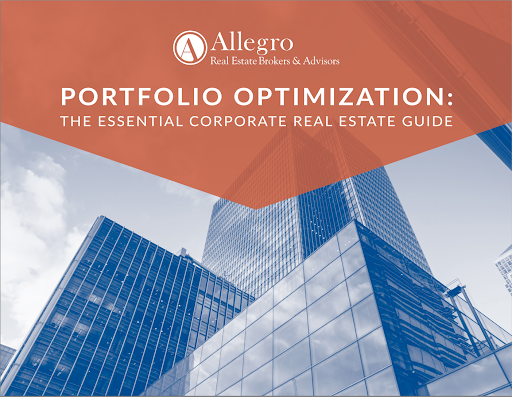As business goals and market conditions change, it is critical that businesses remain aware of how these changes impact their commercial real estate portfolio—and their bottom line. To do this, many organizations turn to CRE portfolio optimization.
Portfolio optimization is a process that involves revisiting, reevaluating, and reoptimizing your existing portfolio to ensure that your real estate aligns with business goals. The process includes four strategic steps:
- Current state assessment.
- Future state assessment.
- Scenario planning, strategy, and action plans.
- Implementation.
In this post, we’ll guide you through the scenario planning phase of CRE portfolio optimization.
For everything you need to know about portfolio optimization, download our free whitepaper.
What Is Scenario Planning?
While the portfolio optimization process as a whole is a methodical science, scenario planning is considered an art. It’s a collaborative process that requires a combination of strategic thinking and metrics to create potential situations without risking ROI-impacting failures.
Scenario planning pairs knowledge and metrics of the past with perceptions of the future to aid in commercial real estate portfolio decision making. In this phase of portfolio optimization, the goals are to:
- Evaluate multiple scenarios.
- Develop a preferred real estate portfolio strategy.
- Demonstrate the financial impact of that strategy.
- Develop an action plan for implementation (the final phase).
How To Conduct Scenario Planning in Commercial Real Estate
Scenario planning uses lease, occupancy costs, and forecasted space requirements to determine potential real estate options for your portfolio. When deciding which properties may fit your portfolio best, the Allegro Real Estate Brokers & Advisors team works with you to consider the quantitative and qualitative factors that matter most to your organization.
Quantitative Factors
Quantitative factors are numerical factors that can definitively be measured. In commercial real estate scenario planning, quantitative factors may include any of the following:
- Net present value (NPV). Net present value takes a building’s current net cash flows and your desired rate of return to determine a building’s value to you as an investor.
- Average annual cost. This includes the total cost of expenses to purchase and operate out of the property.
- Cost per square foot. In office scenarios, this refers to the cost per usable square foot, not rentable.
- Square foot per employee. The amount of usable square feet divided by the number of employees likely to use the space. This metric has become increasingly important as remote and hybrid work continue to shape the workplace.
- Average distance to employees. How far away can the property be from commuting employees?
- Average distance to customers. How far away can the property be from visiting customers? This is especially important for retailers who rely on customer traffic.
- Public transit and highway accessibility. Does your company rely on efficient transportation? Or perhaps greater accessibility allows employees and customers to reach your property quicker and easier.
Qualitative Factors
Qualitative factors in CRE scenario planning are measurements of the characteristics of a property. These factors may include:
- Building and location perception. Does the property and surrounding area have a pre-existing reputation that you should be aware of? What sort of property and location characteristics match your business’s brand and values?
- Amenities. Consider the types of amenities, nearby and on-site, that your team deems essential to workplace productivity and job satisfaction.
- Departmental adjacencies. How important is team collaboration to your organization? Which departments interact with each other more frequently than others? Considering the proximity between office spaces and conference rooms may also be essential to your scenario planning.
What Happens After CRE Scenarios Are Created?
Once scenario models are developed and analyzed, the Allegro team works with you to identify the preferred real estate strategy and implementation plan for each individual property within your portfolio. Strategies are always helpful, but definitive property level plans are actionable by stakeholders. Together, property level plans comprise an overall portfolio strategy that can be measured in the short and long term. These measurements or key performance indicators are tracked on a dashboard holding stakeholders accountable to the overall success of the plan.
With the bulk of the research, strategy, consensus building, and goal setting complete, it is time for organizations to enter the fourth and final stage of portfolio optimization—implementation—with confidence.
Align Your CRE Portfolio With Business Strategy
Corporate real estate optimization is fundamental to achieving your business goals and responding to new challenges. Learn more about assessing and adapting your CRE to meet changes in business by downloading our free guide, Portfolio Optimization: The Essential Corporate Real Estate Guide.







